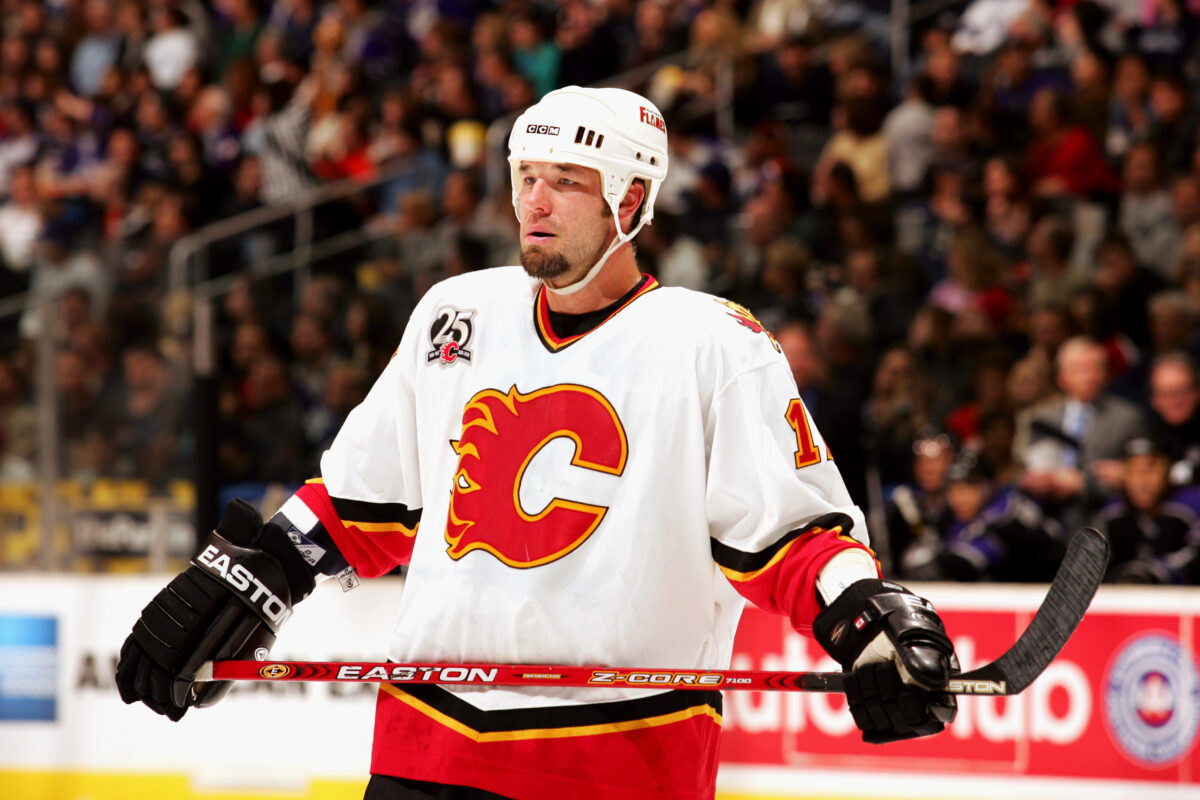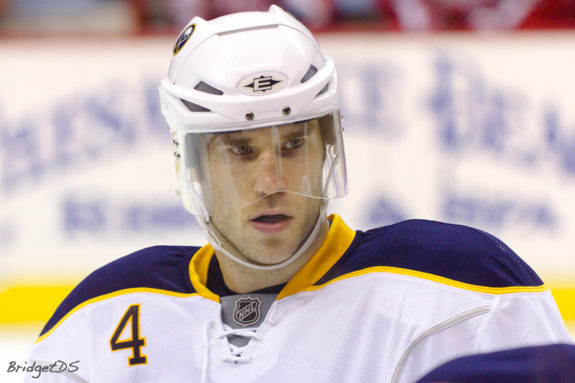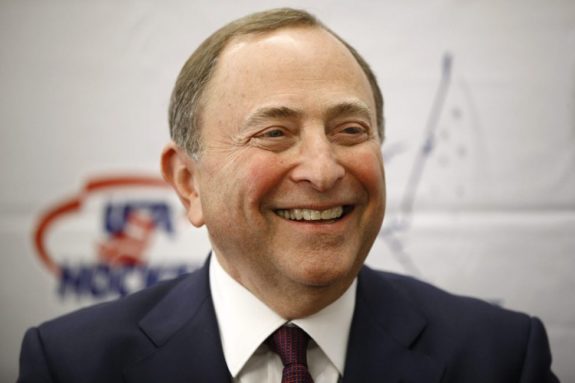Chris Simon lived by the sword over 15 seasons in the NHL, absorbing countless punches to his head in the 111 scraps he notched on his belt. Yet, he died by his own hand on March 18 at the age of 52.
His family said that “we strongly believed and witnessed firsthand that Chris struggled immensely from CTE (chronic traumatic encephalopathy), which unfortunately resulted in his death.” CTE is a progressive degenerative neurological disease affecting people who have suffered repeated concussions and traumatic brain injuries that may occur in some athletes and others who have been exposed to concussions and repetitive hits to the head.

The NHL would have none of this, with the league’s deputy commissioner Bill Daly saying that the “science is still lacking” when it comes to establishing a link between CTE and repeated shots to the head. For good measure, NHL Commissioner Gary Bettman said of Simon’s death, “On all of these matters, we wait to see what the medical experts tell us.”
It seems the NHL remains determined to deny any link between head trauma among its players and CTE despite all the evidence that it’s real. Let’s look at the consequences of that for the game of hockey and the NHL’s business interests. What are the risks the NHL runs in continuing to ignore the alarm bells set off by Simon’s demise?
The NHL Sticks its Head in the Sand on CTE
Don’t get me wrong. It’s not that the league is unsympathetic to the passing of yet another tough guy by his own hand. On the day Simon died, there were the customary expressions of grief, shock and sympathy from across the hockey world. Tributes poured in from the NHL, the NHL Alumni Association and every NHL team for whom he ever skated. These expressions of grief, shock and sympathy were not the place to debate or even acknowledge the possible role of CTE in his suicide.
Sign up for our NHL History Substack newsletter
Yet, in the weeks following his death, what is striking is the absence of any public discussion coming from the league’s official circles of even the possibility of a link between CTE and the death not only of Simon but of many other NHL enforcers over the years. The NHL doggedly clings to its position that the head injuries many of its players incur while plying their trade aren’t the proven cause of the CTE that many may endure later in life.
CTE afflicts the NHL’s pugilists like Simon to a greater degree than other players. It’s one of the reasons that no other professional sports league tolerates players assaulting one another. For that matter, much of the international hockey world refuses to put up with it, either.
Related: NHL Should Start the Process of Outlawing Fighting
Fighting is met with immediate ejection from the game in these leagues. Yet, in the NHL, not only is fighting considered an essential part of the game, but for the most part, it is simply met with a major penalty after which participants return to play for the remainder of the game.
In any modern work setting, employers have an obligation to do everything reasonably possible to protect their employees from being injured and to compensate them when they are. I agree that wiping out head injuries in the NHL is all but impossible – it’s just the nature of the game. Yet, a good portion of these injuries could be eliminated simply by banning fighting. If that’s going too far for the NHL, then at the very least, they must ensure their enforcers understand the risks to the long-term health of their chosen specialty.
The NHL profits handsomely from the hits their players take and those they give out, whether with a body check or their fists raining down on an opponent’s head. The resulting pain and suffering of their players generate huge profits for most franchise owners. Yet, once a player like Simon is finished, the NHL then abandons them, claiming they have no responsibility for their welfare.
Just ask the family of Steve Montador. He died suddenly at 35 years old, and an autopsy revealed he suffered from CTE. During his 10-year career in the NHL, he suffered at least 11 concussions and fought 69 times.

In a lawsuit the Montador family launched against the league in 2015 seeking compensation for the death of their son, the league argued that it is “not to blame for any of the injuries or health problems” that Montador had. The NHL said that it has no duty to study head injuries, no duty to inform its players about such studies and that it has no duty not to promote violence. Montador’s family is still waiting for the case to go to trial.
NHL Has Made Some Progress on the Problem of CTE
To be fair to the NHL, while it hasn’t accepted a link between concussions and CTE, it has adopted the Concussion Evaluation and Management Protocol. It has also taken some steps to reduce the number of concussions in the league by cracking down on headshots.
Related: NHL Has Come A Long Way on Mental Health
Fighting is becoming less frequent, and the number of enforcers seems to decrease every year. According to Hockey Fights, there have been 219 fights this season through to the end of February, with 63 more projected before the playoffs begin for a total of 282. That would be a sharp drop from the 789 in 2003-04. That is a 200 percent decrease over 20 years and significantly down from 645 as recently as 2010-11. According to Bettman, eight of 10 NHL games never see a fight.
As for the incidents of concussions in the league, a JAMA study published in late 2023 showed that after Rule 48 was implemented, which prohibits direct hits to the side of players’ heads, the rate of concussions caused by such hits went from 1.6 concussions per 100 games to 1 per 100 games. Even so, the overall number of concussions in the league has gone up.
On the legal front, the NHL reached an out-of-court settlement in a 2018 Minnesota class action lawsuit totaling $18.9 million filed by 30 retired players who claimed the NHL failed to protect them from head injuries or warn them of the risks involved in their profession. What’s telling is that the NHL spent $70.9 million on the lawsuit – almost four times what it shelled out to the plaintiffs and did not acknowledge any liability.
NHL Needs to Follow NFL’s Lead on CTE
If admitting a problem is the first step in solving it, then the National Football League (NFL) is miles ahead of the NHL. Just as the NHL does now, the NFL spent years denying liability for head injuries to its players. That was until 2016 when Jeff Miller, the NFL’s senior vice president of health and safety policy, was part of a round-table discussion with the U.S. House Committee on Energy and Commerce when Representative Jan Schakowsky asked him, “Mr. Miller, do you think there is a link between football and degenerative brain disorders like CTE?”
Miller replied, “The answer to that question is certainly yes.” The NFL issued a statement the next day, saying, “The comments made by Jeff Miller yesterday accurately reflect the view of the NFL.”
It’s not only admitting that head injuries its players suffer in football causes CTE that sets the NFL apart from the NHL. The NFL reached a much larger settlement with some 20,000 retired players and set aside $1.5 billion over 65 years to deal with claims resulting from head injuries.
What’s more, the NFL has introduced rule changes to try to reduce concussions. Last season, the NFL modified its kickoff rules, and concussions on kickoffs dropped by 60 percent in the regular season.
Over the past few years, the NFL has also used data from sensors on headgear to improve helmets. Every year, the league bans lower-performing helmets as safer ones become available. This season, seven of the top helmets from 2020 were banned.
Not only that, but the NFL claims it slowly ramps up preseason contact conditioning. As Dr. Daniel Daneshvar at Harvard Medical School notes, “Over two-thirds of head impacts for a football player occur in practice. And so, if we eliminate half of the head impacts that occur in practices, we could decrease the risk of CTE for an average, say, offensive linemen, by about 50 percent over eight years.”
The league also introduced more requirements for the use of protective Guardian Caps, which are padded helmet covers that soften hits. They saw a 50 percent reduction in concussions.
NHL Needs To Protect Its Game
Clearly, concussions have turned into a public relations disaster for the NFL, and they have tried to address it. The league knows that issue is bad for its long-term business, given the downward trend in football registration among young players.
Hockey is seeing the same trend. To be sure, part of the challenge for hockey is the cost of enrolling youngsters in the sport. Even so, it’s believed that one of the reasons minor hockey has seen declining enrollment is that parents are worried about the risk of concussions. Plenty of parents simply aren’t going to sign their kids up for hockey knowing that there’s a real chance of them having their brains scrambled by a headshot.
Any sport that loses its popularity amongst youth loses its future ticket-buying audience. The NHL needs to take a long-term view of its business and become a steward of the game. One way to do that is to get serious about reducing head injuries.
NHL’s Long History With CTE
Interviewed last April by NPR in the United States, Bettman reacted sharply to the suggestion that head injuries in the NHL cause CTE saying, “We listen to the medical opinions on CTE, and I don’t believe there has been any documented study that suggests that elements of our game result in CTE. There have been isolated cases of players who have played the game [who] have had CTE. But it doesn’t mean that it necessarily came from playing in the NHL”.

Bettman bristled at the suggestion that head injuries in hockey and football were similar, saying, “The two are not comparable in terms of the amount of contact.” Despite what he says, studies have shown that football and hockey are among the sports with some of the highest incidents of concussions.
I get that it’s Bettman’s job to deny the link between head injuries and CTE in hockey and to steadfastly refuse to accept that the league has any responsibility for those players suffering from the disease nor to protect them. NHL owners have entrusted him to protect their financial interests. Yet, that doesn’t make the denials and refusal to accept responsibility right. Not when so many of the players who generate the handsome profits enjoyed by the owners will go on to live out their lives in misery with CTE.
Not only that, but it opens the league to charges that in its denials of any link between CTE and head injuries incurred in its game, it is behaving like big tobacco and alcohol companies. That’s the view of at least one Canadian Senator – Patrick Brazeau. It’s just not good for the business of professional hockey.
Despite Bettman’s claims, the evidence for a link between head trauma in hockey and CTE is compelling. Take, for example, a 2022 study authored by Dr. Jesse Mez, an investigator with Boston University’s CTE Centre. It concluded that “While the absolute risk for ice hockey players of developing CTE is still unknown, it may be concerning to athletes and their families that we found each year of ice hockey play may increase the odds of developing CTE by 23 percent.”
A study published in the spring of 2023 by the Journal of the American Medical Association Network (JAMA) concluded that NHL enforcers with 50 or more career fights or three or more penalty minutes per game died 10 years earlier and more often of drug overdose and suicide when compared with age-matched NHL player controls.
If academic studies aren’t enough to convince the NHL that head injuries in hockey increase the odds of its players developing CTE, then the number of players who have been definitively diagnosed with it following autopsies should be.
A well-known case is that of Derek Boogaard, who died alone in his New York apartment in 2011 at just 28 years old. The official cause of death was an overdose of oxycodone and alcohol, used to cope with depression. An autopsy revealed that he suffered from CTE that was more advanced than Bob Probert’s, a former NHL enforcer with a terrible substance abuse problem who had died at age 45. Had Boogaard lived to Probert’s age, doctors say he likely would have suffered from dementia. Neither player was ever treated for CTE, depression or addiction.
After Boogaard’s death came the suicide of Vancouver Canucks brawler Rick Rypien, who suffered from depression. Shortly after that, Wade Belak, a fierce fighter who also suffered from the disorder, was found dead in a Toronto hotel room a few blocks from the Air Canada Centre (now the Rogers Centre), where he had played for the Toronto Maple Leafs. It is suspected that he took his own life.
Belak’s wife said her husband, “knew his role. He didn’t love it, but he was fine with it [because] he wanted to stay within the NHL and have his career. He told me, ‘I can’t stay here unless I fight.'”
Yet, the relationship between head injuries and CTE among NHL players goes back years – it just wasn’t understood or talked about back in the day. Autopsies on Buffalo Sabres great Rick Martin, Montreal Canadiens Hall of Famer Henri Richard, two-time Lady Bing Memorial Trophy winner Stan Mikita and Reggie “The Ruffian” Fleming show they had all developed CTE. Of the three, only Fleming was an enforcer and that seems to suggest that the frequent concussions in hockey caused by collisions with other players or the boards also take their toll on players’ brains.
CTE Problem Not Going Away for NHL
Until the NHL takes a page from the NFL’s playbook and gets serious about dealing with CTE, Chris Simon won’t be the last tough guy to end his own life. Years from now, many of today’s up-and-coming enforcers will die from having their brains scrambled too many times.
Pretending that there is no link clear link between head trauma and CTE and that even if there were, it’s not the NHL’s responsibility to do anything about it will hurt the NHL’s business and the game itself.
